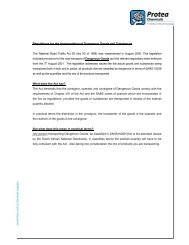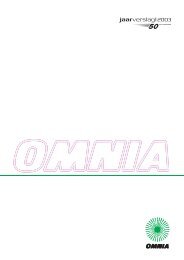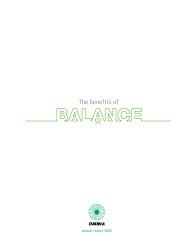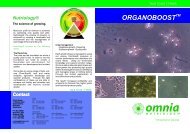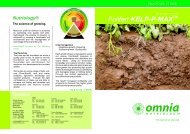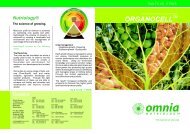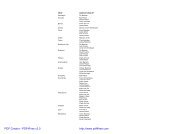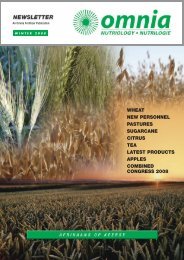omnia holdings annual report 2010 omnia holdings annu
omnia holdings annual report 2010 omnia holdings annu
omnia holdings annual report 2010 omnia holdings annu
You also want an ePaper? Increase the reach of your titles
YUMPU automatically turns print PDFs into web optimized ePapers that Google loves.
80 OMNIA ANNUAL REPORT <strong>2010</strong> FINANCIAL STATEMENTS continued<br />
NOTES TO THE GROUP FINANCIAL STATEMENTS continued<br />
for the year ended 31 March <strong>2010</strong><br />
probable that future economic benefits associated with the<br />
item will flow to the Group and the cost of the item can be<br />
measured reliably. The carrying amount of replaced parts is<br />
derecognised. All other repairs and maintenance are charged to<br />
the income statement during the financial period in which they<br />
are incurred.<br />
Borrowing costs incurred for the construction of any qualifying<br />
assets are capitalised during the period of time that is required<br />
to complete and prepare the assets for their intended use.<br />
Borrowing costs relating to the construction of a plant were<br />
capitalised. Other borrowing costs are expensed.<br />
Freehold land is not depreciated. Other classes of property, plant<br />
and equipment are stated at cost less accumulated depreciation<br />
and any impairment losses. Where the carrying amount of an<br />
asset is greater than its estimated recoverable amount, it is<br />
written down immediately to its recoverable amount.<br />
Depreciation is calculated to write off the cost of property, plant<br />
and equipment, including assets under finance leases to their<br />
residual value, over their estimated useful lives on a straight-line<br />
basis. Improvements to leasehold property are depreciated over<br />
the lesser of 50 years or the period of the lease. Expected<br />
useful lives are as follows:<br />
� Buildings 50 years<br />
� Plant and machinery 4 – 20 years<br />
� Furniture, vehicles and equipment 3 – 5 years<br />
Annually, at the balance sheet date, an estimate is done of the<br />
remaining useful lives and residual values of property, plant and<br />
equipment. Adjustments are made prospectively to the<br />
depreciation charge to reflect the change in the useful life or<br />
residual value.<br />
Gains and losses on disposal are determined by comparing<br />
proceeds with the carrying amount and are included in other<br />
operating income in the income statement.<br />
1.3 Impairment of non-financial assets<br />
Assets that have an indefinite useful life (for example, goodwill)<br />
are not subject to amortisation. These assets are tested <strong><strong>annu</strong>al</strong>ly<br />
for impairment and whenever events or changes in circumstances<br />
indicate that the carrying amount may not be recoverable. Assets<br />
that have a definite useful life and are subject to amortisation are<br />
reviewed for impairment whenever events or changes in<br />
circumstances indicate that the carrying amount may not be<br />
recoverable. An impairment loss is recognised in the income<br />
statement for the amount by which the asset’s carrying amount<br />
exceeds its recoverable amount. The recoverable amount is the<br />
higher of an asset’s fair value less costs to sell and value-in-use.<br />
For the purpose of assessing impairment, assets are grouped at<br />
the lowest levels for which there are separately identifiable cash<br />
flows (cash-generating units).<br />
At each <strong>report</strong>ing date an assessment is made whether there<br />
is any indication that an impairment loss recognised in prior<br />
periods for assets may no longer exist or may have decreased.<br />
If any such indication exists, the recoverable amounts of those<br />
assets are estimated. The increased carrying amount of the<br />
asset attributable to a reversal of an impairment loss does<br />
not exceed the carrying amount that would have been<br />
determined had no impairment loss been recognised for the<br />
asset in prior years. A reversal of an impairment loss of<br />
assets carried at cost less accumulated depreciation or<br />
amortisation, other than goodwill, is recognised immediately in<br />
the income statement.<br />
1.4 Revenue recognition<br />
Revenue comprises the fair value of the consideration received<br />
or receivable for the sale of goods and services in the ordinary<br />
course of the Group’s activities. Revenue is shown net of<br />
value-added tax, returns, rebates and discounts and after<br />
eliminating sales within the Group.<br />
The Group recognises revenue when the amount of revenue can<br />
be reliably measured and it is probable that future economic<br />
benefits will flow to the entity and when specific criteria have<br />
been met as described below. The amount of revenue is not<br />
considered to be reliably measurable until significant<br />
contingencies relating to the sale have been resolved. The<br />
Group bases its estimates on historical results, taking into<br />
consideration the type of customer, the type of transaction and<br />
the specifics of each arrangement.<br />
Revenue from the sale of goods is recognised when all of the<br />
following conditions have been satisfied:<br />
� the Group has transferred to the buyer the significant risks<br />
and rewards of ownership of the goods;<br />
� the Group retains neither continuing managerial involvement<br />
to the degree usually associated with ownership nor<br />
effective control over the goods sold;<br />
� the amount of revenue can be measured reliably;<br />
� it is probable that the economic benefits associated with the<br />
transactions will flow to the Group; and<br />
� the costs incurred or to be incurred in respect of the<br />
transaction can be measured reliably.<br />
Revenue from the provision of services is recognised in the<br />
accounting period in which the services are rendered, by<br />
reference to completion of the specific transaction assessed on<br />
the basis of the actual service provided as a proportion of the<br />
total services to be provided, when the following conditions<br />
have been satisfied:<br />
� the amount of revenue can be measured reliably;<br />
� it is probable that the economic benefits associated with the<br />
transactions will flow to the Group;<br />
� the stage of completion of the transaction at the balance<br />
sheet date can be measured reliably; and<br />
� the costs incurred for the transaction and the costs to<br />
complete the transaction can be measured reliably.<br />
Other revenue earned by the Group is recognised on the<br />
following basis:<br />
� dividend income: when the Group’s right to receive payment<br />
is established.<br />
� interest income: based on the effective interest rate<br />
method.



